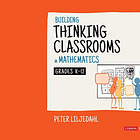The Right Way To Do Think-Pair-Share
The crucial mistakes we make when facilitating discussion—and how to avoid them.
After working with hundreds of educators as a traveling one-man professional development band, I’ve found that think-pair share (TPS) is a go-to facilitation strategy for many instructors, and for good reason. This well-evidenced approach to classroom dialogue is popular across all levels of US education. But for as many times as I’ve seen it done effectively, I’ve seen it done poorly just as often.
There are several ways to derail a good think-pair-share: giving students unhelpful discussion prompts, allowing too little time for the thinking and pairing steps, and turning the “share” into a stale report-out with no lively discussion to follow. When we select TPS from a short list of student engagement strategies we’re looking to shoehorn into our lessons, how often are we asking, “What skills does this format allow my students to develop?” If we don’t design TPS activities around specific learning outcomes, it’ll dissolve into another tool for content coverage and seeing whether students did the reading or not.
I hope that when you implement the tips outlined in this article, the next think-pair-share you facilitate will leave you saying, “Wow…that was an amazing discussion. I love my students.”
What we know about think-pair-share
Defining TPS
Think-Pair-Share is a cooperative discussion strategy where students are asked to think about a topic on their own, discuss their ideas with a classmate, and then share the contents of their discussion with the class.
Frank Lyman and his University of Maryland College Park colleagues pioneered the practice in 1981. Lyman intended for TPS to be a reflection exercise that students complete before launching into class discussions, which I’d say is different from how most educators utilize TPS today. Though I believe TPS can be used as both an appetizer and a main course for dialogue, considering TPS’s original use as a pre-discussion exercise is a helpful reminder that there’s more work to do if we want to fully reap its benefits.
Here’s how Think-Pair-Share is typically facilitated (source: Saint Mary’s Press):
Explain the think-pair-share method ahead of time if the students are unfamiliar with it.
Ask the students a question, writing it on the board if necessary, and give them a time frame for considering it. Allow about 30 to 60 seconds for this step; provide a longer time period if the students will be writing down their thoughts.
Group the students in pairs and direct them to explain their thinking to each other. Give them several minutes to complete this step. Remind the students to be respectful speakers and listeners during the process.
Bring the students’ attention back to the larger class. Repeat the original question, and invite the students to share their responses. Give as many pairs as possible the chance to share their thoughts. After the pairs are done sharing, continue discussing the question as a class.
Though this seems like a sensible structure, the “explain their thinking” and “continue discussing the question” steps are vague. The rest of this article offers suggestions on how and why your students should complete these steps.
What TPS does right
According to Lyman’s most recent open-access article on TPS, the framework helps students do the following:
Retrieve and make connections with course material: Instructors gauge student understanding of key concepts through their ability to retrieve and connect concepts.
Identify commonalities and differences in perspectives: Students recognize links between different course concepts or personal experiences while acknowledging and sharing alternative viewpoints.
Reflect on their learning: Often used as an exit ticket after assignments to see how students processed and internalized the material.
Expose students to diverse perspectives: Creating a culturally-responsive classroom by centering students’ ideas colored by their lived experiences.
Model professional collaboration: Students use "we" when speaking to showcase a collaborative approach.
Building community and conversation: Students foster a sense of community, encouraging further discussion among the larger group.
Think critically: Students share diverse ideas, leading to a more comprehensive understanding of the course content.
Clarify confusion: Groups identify areas of uncertainty and collectively seek clarification; they explain what they were confused about and give their “ah-ha!” moment for classmates to learn from.
"Own" the learning: For more open-ended questions, sharing requires pairs to collaborate and articulate their shared understanding, demonstrating ownership of their learning.
I posit that the goals listed above are what we should be explicitly challenging students to do as they think, pair, and share. When they veer away from these goals, we as instructors should guide them back on track.
It’s worth mentioning that this study was done with a graduate-level teacher education course, where the authors made considerable additions when implementing TPS in this context. However, the desired outcomes and observations from this study give us a sense of what’s possible when we effectively facilitate TPS.
Mistakes to avoid
Don’t assign roles to students.
When we assign roles to students—in fear that the cognitive labor won’t be distributed equally among group members—we rob them of the ability to own their learning process. Common roles include note taker, time keeper, artist (those charged with visual demonstrating the pair’s conversation), and (the one that students dread most) the reporter.
Instead: Since doing group share-outs often places the burden on the ‘reporter’ and absolves the other students in that group from contributing to the larger discussion, don’t ask groups or pairs to share out. See the “pair” part of TPS as simply a scaffolding tool for the bigger discussion. Reinforce that everyone is expected to contribute to the conversation, even if someone from their pair or group has already shared. I find roles for group/pair work unnecessary. The instructor should be the one keeping track of time, buzzing around to each group and helping them demonstrate their thinking in different ways. I want my students to be less focused on “doing they’re job” and more on being present and engaged in discussion.
Don’t ask students to share summaries of what their group discussed.
Synthesizing key points is a valuable learning skill, but centering this as the primary objective of the “share” step nullifies the other skills listed above. The “reporters” spend most of their cognitive bandwidth trying to make sure that everyone in their group is satisfied with how they’ve captured the group’s ideas instead of connecting the new ideas to their own understanding.
Instead: Pairing isn’t about negotiating ideas or forcing consensus. To combat these default assumptions, model how you’d like students to share their learnings from the “pair” step. For instance, give an example of how they could identify commonalities and differences in perspectives. When introducing TPS to students, you could say something like:
“And when we come back together for our discussion, I want us to each share how our discussion with our partner(s) either compliments or challenges our analysis of [insert topic]. It doesn’t have to be a full summary. Choose one or two arguments and explain how they either shifted your view or reinforced your view on _________. If another group shares an argument in real time that you’d like to comment on, you can discuss that instead. The goal here is to identify what we perceive as complimentary or conflicting arguments.”
Don’t rush it.
If you’re too eager to call on a student when no one’s volunteering, or if you blurt out a follow-up question too quickly, you’ve just disrupted students’ thinking. None of this works without allowing adequate time to think.
Instead: Add one extra minute to what you’d usually allot for the ‘think’ step. For topics that are complex or deeply personal, you might replace the “think: step with a 2- to 5-minute free writing exercise in response to a prompt. This allows students to practice articulating their ideas on paper before they share them with classmates. I’ve found this helpful when facilitating delicate conversations about race, politics, identity, and tragic historical events.
In addition to allowing more than the typical time allowed for the think step, give students one or two minutes to think immediately after the “pair” step. This gives them time to process all they’ve heard from their peers, form their analysis, and plan what they want to share with the class. Keep a few backup questions ready in case students seem unsure of where to take the conversation next. Make sure your questions are aligned with the learning goals listed in the “What it does right” section of this article, along with other learning goals you have for that week.
Gracefully embracing the (seemingly) awkward silences and on-the-fly questioning is a critical skill that takes time to develop. I remember one professor who waited 30 seconds for a class full of students to respond to a question he posed. 30 SECONDS! If it’s a good question, the listener needs ample time to think about it. Trust that your questions are good. More importantly, listen to how students respond to those questions. The effectiveness of your questions is evident through the thoughtfulness of your learners’ responses and whether they reach the stated learning goals. Practice makes patience, and patience makes purposeful discussion.
Conclusion
I’d say we rebrand Think-Pair-Share to ‘Think-Pair-Discuss’ to emphasize that TPS is an entry point into intellectually rigorous, empathic, generative, and emergent discussion. TPS promotes thinking in real time; it’s not just students sharing the cumulative outputs of a conversation.
TPS is an effective practice, but only if we remember why we’re doing it and the mistakes to avoid when facilitating it.
Need a facilitator/faculty trainer on inclusive teaching strategies? Visit jdspeaks.com/educators to learn more about my programming, and email booking@jdspeaks.com to inquire about bringing me to your school or campus.





